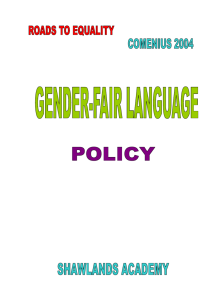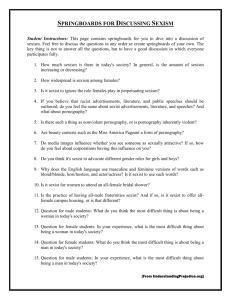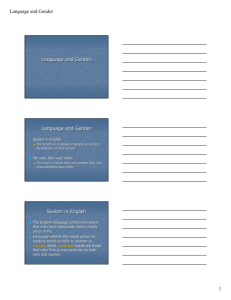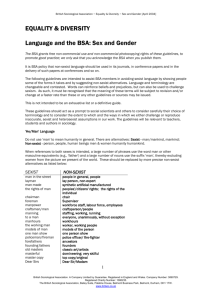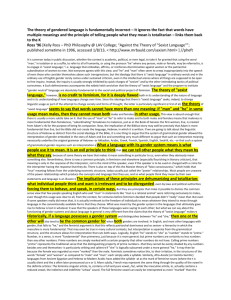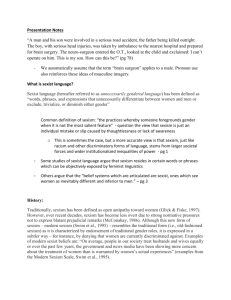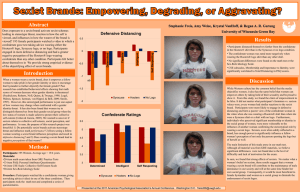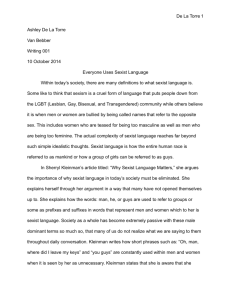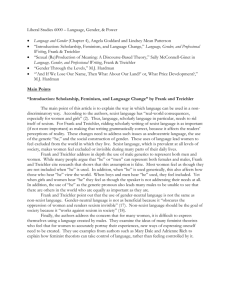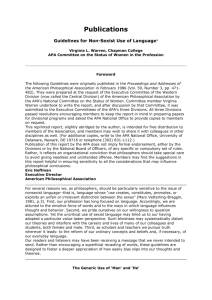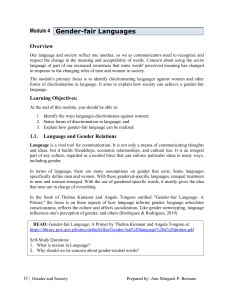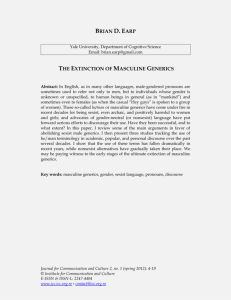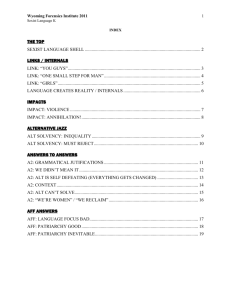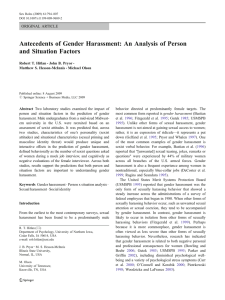gender-fair language - a style book
advertisement
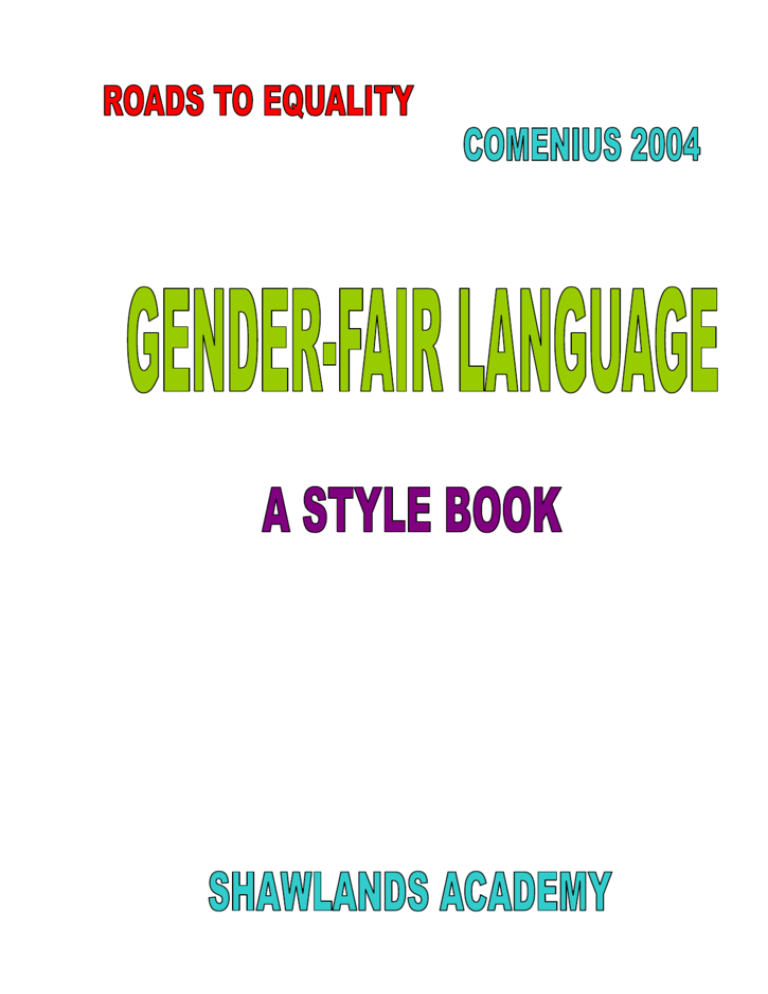
GENDER-FAIR LANGUAGE - A STYLE BOOK INTRODUCTION The issue of sexism in language has given rise to lively debate over the years and many organisations such as Universities and Newspaper Unions have provided their employees with a style book so that they will be able to avoid language which may be considered offensive or discriminatory. This unit will look at some of these issues and provide alternatives for some of the terms which have been objected to as sexist in nature. GENDER-SPECIFIC INSULTS The most obvious sexist language occurs in gender-specific insults which are used only against girls and women. These are not only hurtful and demeaning but also discriminatory and as such should be combatted in the same way as racist insults. Terms such as cow, bitch, dog, bat, shrew, crow, cat, slag, slut, slapper, scrubber, etc are not used on boys and as such are effectively contemptuous of all women. Because this is the most blatant incidence of sexism in language, it can be easily identified as offensive. However there are many other more insidious ways that sexism manifests itself in the language we use every day and these also must be addressed if we are to work in an environment that is fair to all. LANGUAGE CAN PERPETUATE DISCRIMINATION Language does not just describe the world in some neutral or arbitrary manner but simultaneously evaluates it. Language and society evaluate each other so we must be aware of the effects of the language we use. Language can be inadvertently sexist – words and phrases in common use can both reflect and reinforce prejudice against women, so perpetuating discriminatory attitudes and bias. Sexism in language is pervasive and we may at times be completely unaware of it. It may be unintended as it arises from an unconscious use of language that carries the values of a sexist society. Thus writing and speaking can seem ‘normal’ and ‘common sense’ usage but still perpetuate unfairness. Any attempt at a non-sexist language will of course at first feel forced and unnatural but experience has shown that this awkwardness will become normal as its use spreads. Obviously we cannot be responsible for what is written in society in general (e.g tabloid newspapers) but we should be able to recognise sexist language when we see it. Just as we try to avoid terms which discriminate against people’s religion, ability, sexuality or ‘race’ we must also pay attention to gender. Douglas Hofstadter wrote an essay illustrating this point. He imagined a world where ‘white’ was used for ‘whites and blacks’ in the way we presently use ‘man’ for ‘men and women’. Most of the clamour, as you certainly know by now, revolves around the use of the age-old usage of the noun ‘white’ and words built from it, such as chairwhite, mailwhite,……. The negrists claim that using the word ‘white’, either on its own or as a component, to talk about all the members of the human species is somehow degrading to blacks and reinforces racism. Therefore the libbers propose that we substitute ‘person’ everywhere where ‘white’ now occurs. Sensitive speakers of our tongue of course find this preposterous. There is great beauty to a phrase such as ‘All whites are created equal’. Our forebosses who framed the Declaration of Independence well understood the poetry of our language. Think how ugly it would be to say ‘All persons are created equal’ or ‘All whites and blacks are created equal’. (Hofstadter 1986) Sexist language, intentional or not, is any item of language which through its structure or use trivialises, insults or renders women invisible by presenting a society in which ‘male’ is seen as the unmarked norm. These guidelines are designed to raise awareness and debate about sexist language and stereotypes. THE USE OF ‘MAN’ AS GENERIC The generic use of ‘man’, ‘he’ and ‘his’ is misleading for the audience. Research by Wendy Martyna (The Psychology of the Generic Masculine) and by Schneider and Hacker at Drake University has shown that the average reader/listener will tend to imagine a male when reading ‘he’/’man’ even when the rest of the passage is gender-neutral. The latter investigators used two versions of the same sociology textbook – one with chapter headings like ‘Social Man’, Industrial Man’ and ‘Political Man’ and the other with headings ‘Society’, Industrial Life’ and ‘Political Behaviour’. Three hundred students were divided into two groups and each group was given one version of the textbook with a view to providing illustrations for the text. Analysis of the pictures chosen showed that those students using the first version chose predominantly pictures of men while the latter group provided a much more balanced selection. The authors concluded, ‘This is rather convincing evidence that when you use the word man generically, people do tend to think male, and tend not to think female.’ Women can therefore become invisible in the ‘history of man’. We should avoid using ‘man’ to mean ‘humanity’ in general as there are alternatives. man mankind person, people, humans men and women, humanity, humankind This avoids such statements as ‘Early Man’, ‘Man and his World’ and ‘Man, being a mammal, breastfed his young.’, ‘The effects of PCBs has been studied extensively in rats and man.’ (All genuine examples from textbooks). THE USE OF ‘MAN’ IN SUFFIXES OR PHRASES For the reasons given above these terms can be misleading in modern society and exclude women from the picture we present of the world. Again there are alternatives which avoid discrimination and bias as can be seen in the examples of common words and phrases below: man in the street man-made the rights of man brotherhood of man chairman foreman fireman one man show policeman man and wife man hours manned space flight manning (the office) the average person manufactured, synthetic people’s/citizens’ rights human community chairperson, chair, convener supervisor firefighter one person show police officer husband and wife work hours crewed/piloted space flight staffing, working in, running In some cases where the gender of the person is known (e.g chairman, chairwoman or one man show, one woman show) it is possible to be specific. In other cases the masculine should not be used as a generality when the gender is unknown or the category contains both men and women. THE USE OF ‘FEMININE’ SUFFIXES These suffixes generally imply a diminutive or a less important variation of the ‘masculine’ norm. Most agent-nouns in English are common gender and can be used for men and women: actress poetess heroine ballerina priestess waitress hostess actor poet hero ballet dancer priest waiter host THE USE OF THE GENERIC ‘HE’, ‘HIM’ and ‘HIS’ The generic ‘man’ is often accompanied by the generic pronouns ‘he’, ‘him’ and ‘his’. As shown above this tends to filter out the presence of women in a text. The constant use of the masculine pronoun as an unmarked norm is an obvious example of sexism in the language. This can be difficult to avoid and can lead to clumsy constructions like ‘he/she’, ‘s/he’ or ‘his/her’. However it is possible by use of the plural, use of the second person or by omitting the personal pronoun altogether. The driver should take his completed registration form to the window and pay his registration fee. Drivers should take their completed forms to the window and pay their registration fee. You should take your completed form to the window and pay your registration fee. The driver should take the completed form to the window and pay the registration fee. The use of ‘he’ seems neutral through long usage but it is not. The computer magazine MacTech Quarterly (now MacTech Journal) took an editorial decision to use ‘she’ and ‘her’ as generic pronouns instead of ‘he’, ‘him’ and ‘his’. This led to much enraged correspondence and the cancelling of many men’s subscriptions. THE USE OF SEXIST WORDS AND PHRASES Some gender-specific words convey myths and attitudes which can continue the stereotypical ideas of women. Phrases such as ‘lady luck’, woman’s intuition’ or ‘old wives’ tales’ carry the idea of women as illogical and arbitrary. (‘luck’,’ ‘intuition’ and ‘old tales/folklore’ would serve just as well. Similarly the use of ‘she’ for ships, cars (‘she handles well on corners’) may suggest the idea of control. In this area language may be working at a much deeper level where it reflects the inequalities in society. Consider the words and phrases used for women which compare them to types of food to be eaten; crumpet, honey, tart, sweetiepie, dish, sugar,etc; or to animals regarded as unpleasant; bitch, shrew, vixen, cow, dog, crow. Compare these to terms used for men. Consider also pairs of words and their contrasting meanings for men and women, e.g. ‘governor- a man in charge of a country, district, etc’ and ‘governess – a woman who teaches children at home’ or ‘master – a man in control’ and ‘mistress- adulterous lover of a man’. These things are inherent in the language and we should be aware of them and the messages that they subliminally transmit. Language is not transparent or neutral but plays an important part in male and female roles and assumptions. Changes in language can therefore lead to changes in attitude. STEREOTYPING It is necessary to combat sex stereotyping by presenting positive views of both men and women. Newspaper headlines may say, for example, ‘Mother-of Three Scales Everest’ but would not mention a man’s parental status. Positive images which show women and men in flexible diverse roles should be encouraged. Stereotyping is inherent not only in language but also in literature and school text books. Sexist All women characterised as: emotional, weak, irrational, sentimental, dependent, passive inferior, caring, etc All men characterised as: unemotional, strong, rational sensible, independent, dominant, superior, uncaring Non-sexist Both men and women need to be represented as whole human beings with strengths and weaknesses and not being bound to ‘masculine’ and ‘feminine’ characteristics. Sexist language can imply that women as a social group are inferior to men until more people challenge taken-for-granted assumptions about the sexes. CONCLUDING REMARKS This paper has been written to highlight an area of discrimination that may have gone underground over the past decade or so. Some people consider that we are living in a ‘post-feminist’ age when the battle for equality has been won. Any objective analysis of society would show that this is not the case and that there is still widespread discrimination against girls and women. We should all try to combat discrimination where we find it and close examination of the language that we use in everyday life is a good place to start.
